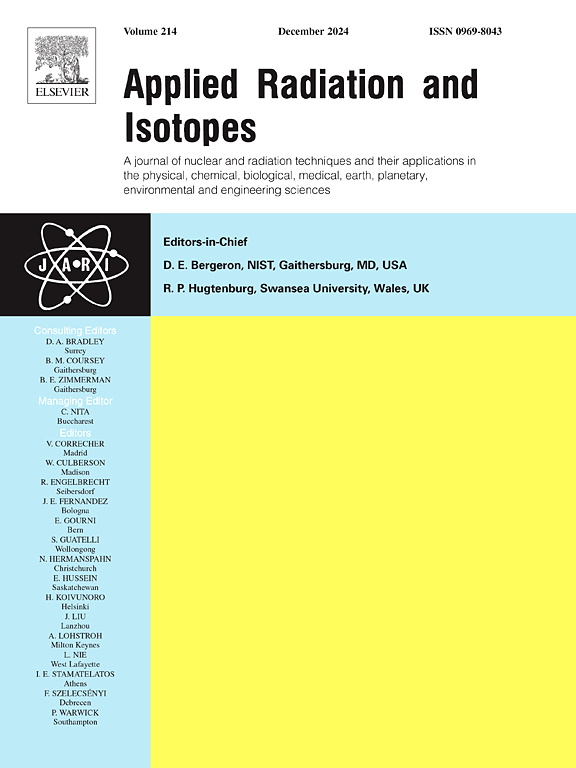印度北方邦阿姆罗哈地区室内氡、梭伦及其后代调查的初步结果
IF 1.6
3区 工程技术
Q3 CHEMISTRY, INORGANIC & NUCLEAR
引用次数: 0
摘要
222Rn、220Rn及其子代的浓度水平是影响自然本底辐射的主要来源之一,因此对它们的测量研究具有重要意义。本文介绍了在印度北方邦阿姆罗哈区12个地点的51所房屋中进行的初步测量结果。单入口双室针孔剂量计、直接氡子代传感器(DRPS)和直接氡子代传感器(DTPS)配备LR-115红色硝酸纤维素膜(SSNTDs)。所有地点和房屋都是随机选择的,用于测量222Rn、220Rn及其衰变产物的浓度,它们是辐射暴露的关键因素。氡(222Rn)的平均浓度在7.58 ~ 52.11 Bq/m3之间,钍(220Rn)的平均浓度在4.05 ~ 21.18 Bq/m3之间。平衡等效氡浓度(EERC)为1.56 ~ 10.52 Bq/m3,平均为3.85 Bq/m3,平衡等效钍浓度(EETC)为0.15 ~ 1.31 Bq/m3。平均0.54 Bq/m3。本文章由计算机程序翻译,如有差异,请以英文原文为准。
Preliminary results from an indoor Radon, Thoron and their progeny survey in Amroha: A district of Uttar Pradesh, India
The study on the measurement of 222Rn, 220Rn and their progeny concentration level is very important as they are one of the most impactful contributors to natural background radiation. This paper presents preliminary results of measurements which took place in 51 houses across 12 locations situated in Amroha district of Uttar Pradesh, India. Single entry-based twin-chamber pinhole dosimeters, direct radon progeny sensors (DRPS) and direct thoron progeny sensors (DTPS) equipped with LR-115 red cellulose nitrate films (SSNTDs). All the locations and houses are randomly selected for measurement of the concentrations of 222Rn, 220Rn and their decay products, which are critical contributors to radiation exposure. The average Radon (222Rn) concentrations varied between 7.58 Bq/m3 and 52.11 Bq/m3, while the average Thoron (220Rn) concentrations ranged from 4.05 Bq/m3 to 21.18 Bq/m3. Also, Equilibrium Equivalent Radon Concentration (EERC) ranged from 1.56 to 10.52 Bq/m3 with mean 3.85 Bq/m3 and Equilibrium Equivalent Thoron Concentration (EETC) levels varied from 0.15 to 1.31 Bq/m3. with mean 0.54 Bq/m3.
求助全文
通过发布文献求助,成功后即可免费获取论文全文。
去求助
来源期刊

Applied Radiation and Isotopes
工程技术-核科学技术
CiteScore
3.00
自引率
12.50%
发文量
406
审稿时长
13.5 months
期刊介绍:
Applied Radiation and Isotopes provides a high quality medium for the publication of substantial, original and scientific and technological papers on the development and peaceful application of nuclear, radiation and radionuclide techniques in chemistry, physics, biochemistry, biology, medicine, security, engineering and in the earth, planetary and environmental sciences, all including dosimetry. Nuclear techniques are defined in the broadest sense and both experimental and theoretical papers are welcome. They include the development and use of α- and β-particles, X-rays and γ-rays, neutrons and other nuclear particles and radiations from all sources, including radionuclides, synchrotron sources, cyclotrons and reactors and from the natural environment.
The journal aims to publish papers with significance to an international audience, containing substantial novelty and scientific impact. The Editors reserve the rights to reject, with or without external review, papers that do not meet these criteria.
Papers dealing with radiation processing, i.e., where radiation is used to bring about a biological, chemical or physical change in a material, should be directed to our sister journal Radiation Physics and Chemistry.
 求助内容:
求助内容: 应助结果提醒方式:
应助结果提醒方式:


